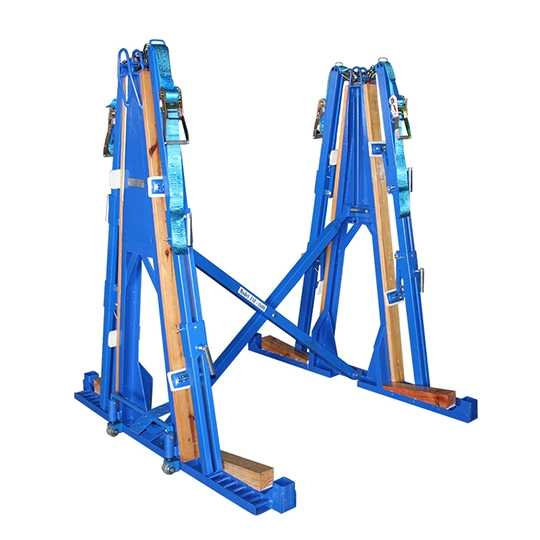Material handling is the foundation of efficiency and safety in any operation that deals with physical goods—whether in construction, warehousing, logistics, or manufacturing. But to fully understand its value, you need to know the core objectives behind modern material handling systems. In this comprehensive guide, we’ll cover the four main purposes of material handling systems, discuss best practices, and explain how leading equipment can drive productivity, reduce labor costs, and keep your workplace safe.

Table of Contents
ToggleWhat Is Material Handling?
Material handling is the science and art of safely moving, storing, protecting, and controlling materials and products throughout their manufacturing, warehousing, distribution, consumption, and disposal. From the simplest handcart to advanced automated warehouses, material handling systems ensure that the right goods are in the right place at the right time, with the least cost and risk.
For a foundational introduction, see What Is Material Handling?
The Four Main Purposes of Material Handling Systems
Whether you’re working with lifting equipment for construction, warehouse automation, or job site logistics, every material handling solution is designed to achieve these four objectives:
1. Move Materials Efficiently and Safely
The primary goal of any material handling system is to move materials from one point to another—within a facility, across a job site, or between buildings—safely and efficiently.
Key Methods:
- Manual tools: wheelbarrows, carts, and pallets
- Motorized equipment: forklifts for construction, electric pallet jacks, and motorized carts
- Mechanical solutions: hoists and cranes, Aardwolf Slab Lifters, and Vacuum Lifters
- Automated systems: conveyors in construction and logistics, automated guided vehicles (AGVs)
Best Practice:
Use purpose-built equipment to reduce manual lifting, cut transport times, and lower the risk of injury or product damage.
2. Store and Organize Materials Effectively
A key function of material handling systems is to provide material storage solutions—keeping goods secure, accessible, and protected until needed.
Modern Storage Systems:
- Pallet racking and shelving: maximizes vertical and horizontal warehouse space
- Bins and containers: organize small parts or loose items
- Automated storage and retrieval systems (AS/RS): optimize space, speed up access, and reduce labor costs
- Construction site logistics: mobile storage units, job site containers, and weatherproof shelters
Outcome:
Good storage reduces material waste, supports inventory control, and ensures the right materials are always available when needed.
3. Protect Materials, Products, and Workers
Material handling isn’t just about movement and storage—it’s also about protection. Systems must safeguard the integrity of products during every stage and protect workers from hazards.
Protective Strategies:
- Proper packaging and restraint: prevents damage during transit or storage
- Specialized lifters: like Vacuum Lifters or Aardwolf Slab Lifters to handle delicate or heavy items with minimal risk
- Safety barriers and equipment guards: shield employees and inventory from accidents
- Training and certifications: ensure only qualified staff operate motorized equipment
Result:
Fewer accidents, less product loss, and compliance with safety regulations.
4. Control Material Flow and Inventory
The final core purpose is control—managing the movement and storage of materials with maximum precision. This includes tracking inventory, optimizing workflows, and minimizing costly delays or errors.
Control Tools:
- Warehouse management systems (WMS): digital platforms to monitor inventory, orders, and movement
- Standard operating procedures (SOPs): ensure consistent, safe, and repeatable material handling
- Scheduled maintenance: keeps all handling equipment (from forklifts to Jib Cranes) in peak condition
Why It Matters:
Good control leads to better planning, lower costs, reduced labor needs, and a streamlined supply chain.
Learn more about integrating these elements at Four Elements of Material Handling.
How Material Handling Systems Support These Purposes
A holistic approach to material handling means integrating all four purposes at every stage of your operation. For example:
- A warehouse uses Vacuum Lifters for gentle, efficient movement (purpose 1), stores goods in pallet racks (purpose 2), uses packaging and safety guards (purpose 3), and tracks everything via a WMS (purpose 4).
- On a construction site, Jib Cranes and Aardwolf Slab Lifters ensure safe lifting, smart storage, and worker safety—all coordinated by site supervisors.
Benefits of Optimized Material Handling Systems
- Reduce labor cost in construction and warehousing
- Improve safety on construction site
- Increase construction productivity
- Minimize material waste
- Ensure regulatory compliance and audit readiness
For best practices and equipment options, visit Material handling Equipment and Material-handling Equipment.
Recommended Equipment for Each Purpose
- Movement: Jib Cranes, forklifts, conveyors, carts, wheelbarrows
- Storage: Racks, bins, AS/RS, mobile site containers
- Protection: Vacuum lifters, slab lifters, safety barriers
- Control: WMS, SOPs, digital inventory systems
Conclusion
The four main purposes of material handling systems—movement, storage, protection, and control—are the pillars of a safe, efficient, and cost-effective supply chain. When supported by the right material handling equipment and best practices, organizations see measurable gains in productivity, safety, and profitability.
Explore more:
- Aardwolf Slab Lifters
- Vacuum Lifters
- Jib Cranes
- What Is Material Handling?
- Material handling Equipment
- Material-handling Equipment
- What Is Material Handling Equipment?
- Which of the Following Is a Motorized Material Handling Device?
- What Is Mechanical Material Handling?
- Four Elements of Material Handling.

















Please log in to leave a comment.